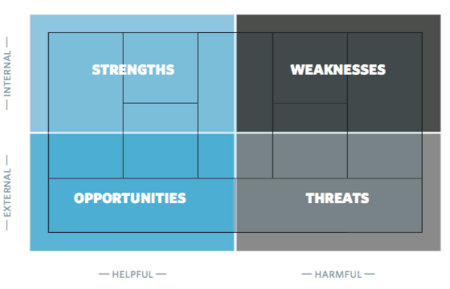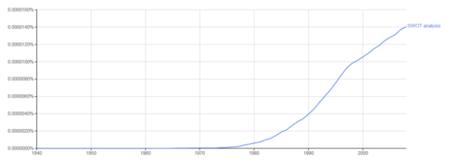SWOT Analysis Management
Developed by Helená Evin Cinar
Contents |
Abstract
The article will shed light on the analysis tool SWOT model.The SWOT analysis is a frequently used method in strategy development in both private and public organizations. A SWOT analysis is an analytical tool when it comes to value-based management and strategy formulation to define strengths, weaknesses, opportunities and threats for a given company. [1]
Strengths and weaknesses can be characterized as internal value-creating (or destructive) factors such as. assets, skills or resources that a company has at its disposal according to its competitors. The factors for the organization's strengths and weaknesses can be measured using internal assessments or by external benchmarking. Opportunities and threats are characterized as external value-creating (or destructive) conditions over which an organization has no direct influence, but instead emerge from the competitive dynamic connections of industry / market or from demographic, economic, technical, social or legal factors. Typically, you will be able to use the SWOT analysis in connection with any organization that intends to create a fit with its external environment.
The SWOT table is an effective tool for analyzing the (internal) strengths and weaknesses of a company and the (external) opportunities and threats. However, this analysis will only be a single link of many when it comes to analysis at an organizational level. In fact, the creation of the adaptation will be a contradictory work to embark on, as the reality behind the SWOT analysis will most often point in contradictory directions, leaving strategists with the paradox of creating adaptation either from the outside (market-driven strategy) or from within. -out (resource-based strategy). [2]
Introduction
The SWOT analysis is a simple and compliant technique. The tool can be used to formulate strategies and working methods for administrators.The SWOT analysis can be approached in many ways, the classic way of setting up models is as illustrated in the 2 by 2 matrix: Strengths, Weaknesses, Opportunities , Threats as illustrated in the abstract. The main purpose of the following article is to illustrate how SWOT can be used by administrators to process, analyze and initiate reflective perspectives within the management area.[3]
History of SWOT analysis
The SWOT analysis was initiated by mangament consultant Albert Humphrey in the 1960s at the Stanford Research Institute. At that time, business planning did not debut as much as it does today, and the method was therefore not considered until companies began to lack a method for planning long-term planning strategies that were executable and compliant. In addition, Humphrey and his research team advised that the SWOT model would be an obvious tool for maintaining accountability and objectivity in the planning phase, since then the SWOT model has been popular with many companies.[4]
According to Albert Humphrey, the idea of the analysis was specifically aimed at criteria such as products, process, customers, distribution, finance and administration. SWOT analysis has over time had some success as it has only grown in popularity since its inception, which is also evident in the Google Books Ngram search[5]How to use SWOT as a tool
When a company needs to complete the analysis framework for the SWOT model, the internal and external environment play a significant part in relation to the strategic planning process. The company's internal environmental factors are classified as: Strengths (S) and Weaknesses (W), respectively, with which the external factors are classified as Opportunities (O) or Threats (T).
The analysis provides the information that is profitable to match the company's resources and capacities according to the competitive environment in which it operates. These considerations contribute to the selection of targeted strategies.
The diagram is a SWOT analysis framework that illustrates how the analysis can be implemented and incorporated into an environmental scan.
Environmental Scan
/ \
Internal Analysis External Analysis
/\ /\
Strenghts Weaknesses Opportunities Threats
┃
SWOT Matrix
strengths
A company's strengths are reflected in its resources and capabilities, which underpin the long-term development of competitive advantages. Frequent examples of these strengths may include:
- Patents - Good reputation among partners and customers - Strong key issues
Weaknesses
When there is failure at certain strengths, it can be termed as a weakness. Sometimes certain weaknesses can be the reverse of strength characteristics in a company. For example, if one were to set a real example with a company with an increased production capacity, this capacity would not necessarily be considered a strength that competitors do not share. This could be defined as a weakness if the large investment in production capacity stretches the legs of the company in acting quickly on changes at the strategic environmental level. Other examples of weaknesses may be:
- Lack of patent protection - Weak issues - Bad reputation among partner / customers - Structures with increased economic costs
Options
The possibilities fall under the category of external environmental analysis. This area could unveil any new opportunities for profit and growth. Relevant examples of options may include:
- An up-to-date customer need - Implementation of new technology - Marginalization of norms
Threats
Making changes in the external environment can, in some cases, lead to threats to the company. Real examples of threats can be:
- Changed consumer needs, leads to customers opting out of the company's products - Replacement products - New standards
Discussion
PROS
CONS
References
[Book: Business Model Generation]
[https://ivaekst.dk/vaekst/0/6/4/3/swotanalyse] - SWOT-ANALYSE - by IVÆKST
[https://files.eric.ed.gov/fulltext/EJ514327.pdf] - Journal of Vocational and Technical Education By Kirk Swortzel
[https://www.lucidchart.com/pages/what-is-swot-analysis#section_5] - What is a SWOT Analysis
Cite error:
<ref> tags exist, but no <references/> tag was found

